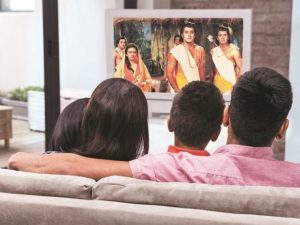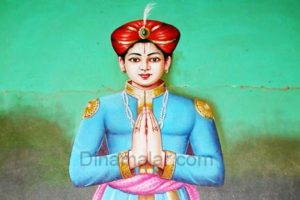A Chennai Businessman

Ramanand Sagar’s mega epic TV serial RAMAYAN, when first telecast in 1987 created unprecedented records. The message of RAMAYAN cut across all the barriers of caste, creed, language and political boundaries. A media documentation of that is found in the website of the Sagars. A sample taken from there: “After watching a scene in which Lakshman becomes unconscious on being hit by Indrajit’s Naga Pasha, a wealthy businessman in Madras fell seriously ill and went into coma at the shock of seeing Lakshman wounded. The credibility and source of the sequence created a great furore. But the Ramanand Sagar team stood their ground. When they received a request from the businessman’s doctor to help them revive the old man, the Sagar unit worked round the clock and prepared a special clipping which they air-dashed to Madras. Only after the man saw Lakshman reviving back to life in the new clipping – also based on authentic research – did he recover back to normal life from his coma”. From www.sagartv.org
An Azhwar of Tirunelveli

Alvars are Vaishnava saints of Tamil Nadu. They are 12 in number. They were the famous authors of Nalayira Divya Prabandham, a collection of 4000 divine poems praising Lord Vishnu. They stand on the same footing of sanctity as Thevaram of the three Tamil Saiva saints. Kulasekara was the king of Kerala and one of the 12 Alvars. Though he discharged his duties as a king regularly he was deeply involved in practising the ancient customs. As part of it he used to listen to Ramayana every day from his Guru. When he was engaged in hearing the story, he came to the stage of Khara Vadha—Killing of demon Khara by Rama single handedly. When he came to know that Rama was fighting all alone, he ordered his army to march to back up Rama. He also put on his armours and went forth to help Sri Ram. Rama lived several thousand years before Kulasekara, but he travelled back in Time, only mentally. There was another occasion when his Guru was narrating the portion of Ramayana where Rama began to cross the sea to Sri Lanka. Immediately he armed himself and went into the sea with his retinue of soldiers!
These incidents and his deep emotional involvement made the ministers to devise a plan to keep him away from the Vaishnava devotees. They want to get rid of them so that he would pay more attention to his royal duties. They deliberately removed the costly jewels from the deity he worshipped and attributed the theft to his Vaishnava devotees and the priest. But Kulasekara did not believe it because he had so much faith in them. He offered put his hand in a pot containing cobras. If the cobras did not bite, it was a monumental proof of the innocence of the Vaishnava devotees and the criminal offence of the ministers. The cobras did not harm him. The ministers realised his sincerity and begged for pardon.
Later he crowned his son as the king and retired to lead a life of penance and prayer. He made an extensive pilgrimage to all the Vaishnava temples in Dakshin Bharat. When he reached Mannarkoil in Tirunelveli district his soul departed from his body. He is the one who composed the well-known Mukundamala in Sanskrit in addition to his Tamil poems ‘Perumal Tirumozhi’ in Divya Prabandham. (From Swami’s Indology Blog)

